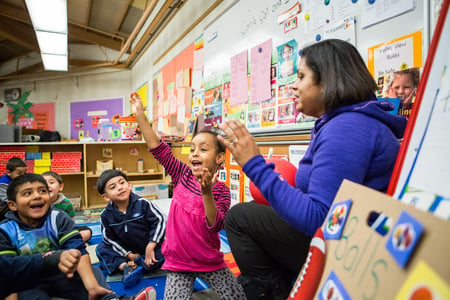
For folks new to the CLASS® system, a frequently asked question usually starts with the basics: “What exactly does CLASS measure?”
CLASS is an observational measure that captures the moment-to-moment interactions that happen within a learning setting. We say “learning setting” instead of "classroom" because CLASS can be used in all types of learning settings, including outdoor spaces, family childcare within a home, early learning centers, public schools, private schools, big kids, little kids—you name it! If there is a focus on supporting learning and development, CLASS can help you understand the effectiveness of the educator-child interactions that are going to have the greatest impact on helping children and educators thrive!
Although there are slight adjustments to account for differences in developmental needs across ages (birth – 12th grade), CLASS measures interactions within three broad categories: 1) interactions that build positive connections among children and educators, 2) interactions that promote engagement, and 3) interactions that inspire learning. So, what are these moment-to-moment interactions? Let’s dig in a little deeper.
Connect
When we think about interactions that build connections among educators and children, we are talking about ways the educator helps to create an environment wherein children feel safe, happy, respected, and cared for. These interactions are captured by the Emotional Support domain.
Observers look for observable behaviors, like smiles and laughter, and even simple gestures, like sitting on the floor with children to play together. All of these behaviors give us clues into how warm, caring, and welcoming the experience is for children.
Observers also look for signs that educators are aware of children’s needs and can effectively help support those needs and resolve problems. This might be things like the educator noticing that a child spilled her drink and offering her a paper towel to clean up, moving closer to a child who is having difficulty sounding out a word and helping them chunk the word into parts, or realizing that a child might feel a bit down one day and taking some time to sit and talk with them.
Connections between educators and children are also strengthened when children feel respected and valued. These moments often involve the educators providing children with autonomy, choice, and opportunities to make decisions in their own learning. Have you ever asked a child to help you hand out papers or get materials ready? Have you ever given children decision-making power related to which book they want to read or how they want to use the materials to create something? Those educator behaviors communicate to children that you trust them and that you value their ideas and opinions!
Engage
CLASS also measures interactions that promote engagement. These are actions that help children regulate their behaviors and stay focused and excited about learning experiences. These interactions are captured by the Classroom Organization domain.
Have you ever walked into a learning setting and it seems like everyone knows exactly what they are supposed to be doing? They may all be doing different things, and it may even be a bit noisy and messy, but everyone is doing something productive! Some things observers look for are things like consistent routines, clear and focused learning goals and expectations, and educators’ making an effort to understand children’s emotions and proactively supporting them in regulating their behaviors so they can get back to work and play more quickly!
Inspire Learning
Finally, CLASS measures interactions that help children think and learn! It includes all of the things educators do and say that facilitate children’s processing of new information and build depth to their understanding. These interactions are captured by the Instructional Support domain.
This may include things like asking children to make a plan, experiment to test out their ideas, and compare or classify whatever content they may be working with.
Observers also look for evidence that the educator is helping children connect content to something relevant in their homes or neighborhoods, how educators introduce new vocabulary, prompt back-and-forth discussions, or ask children to explain their thinking. A simple question like, “What makes you say that?” is a great way to help children think critically!
CLASS also measures interactions related to how educators inspire and support learning through scaffolding, like providing hints, slowing things down, and explaining more carefully.
One thing to note is that CLASS doesn’t measure adherence to a certain curriculum, approach, or teaching style -- it more broadly captures the intentional ways in which an educator facilitates thinking and learning across any context.
Capturing Children’s Experience
CLASS does not only focus on the behaviors of educators. CLASS intends to capture the quality of interactions that children experience! Observers pay attention to how children respond to educators. After all, interactions are not experienced alone -- they require a partner! It is these back-and-forth exchanges and the impact on learners that CLASS is capturing.
So although educators may be primary drivers and initiators of many interactions that CLASS captures, it is really about capturing the experiences of each child to ensure that every child experiences life-changing teaching, one interaction at a time.
CLASS Keeps it Simple
You might be thinking, “Oh, I already do these things… what is unique about CLASS?” And you’re right -- CLASS captures the effective moment-to-moment interactions that great teachers naturally engage in!
What makes CLASS special is that it gives names to these behaviors, allows us to document and measure them, providing a common language and lens. CLASS also gives an opportunity to identify an educator’s strengths and provide personalized support to enhance interactions among children and educators.
We often focus on how effective interactions benefit children, but they also benefit educators! When connections are authentic, children are engaged, and they are inspired to learn, educators feel calm, organized, happy, and effective in their roles. When interactions with and among children are effective, children and educators thrive.
ABOUT THE AUTHORS
 Lexi Alexander is an applied developmental psychologist, specializing in early learning. Over the past eight years, she has co-led the Early Science Initiative, a system of professional learning and family engagement focused on using early science as a driver of high-quality teaching and learning. Her experience as a classroom teacher, knowledge of child development, and being a mother of two young children have inspired and informed her work in numerous projects related to early science and, more broadly, early childhood education.
Lexi Alexander is an applied developmental psychologist, specializing in early learning. Over the past eight years, she has co-led the Early Science Initiative, a system of professional learning and family engagement focused on using early science as a driver of high-quality teaching and learning. Her experience as a classroom teacher, knowledge of child development, and being a mother of two young children have inspired and informed her work in numerous projects related to early science and, more broadly, early childhood education.

Veronica Fernandez is Teachstone's VP of Content Development and Social Impact. She is a developmental psychologist and has spent 15 years focused on the development of early childhood education professionals. Previously, she was a research scientist at the University of Miami where she led the development, implementation, and evaluation of an innovative and impactful coaching intervention. Throughout her career, she has focused on developing and promoting equity, anti-racism, and anti-bias practices.

